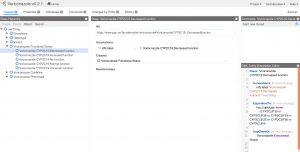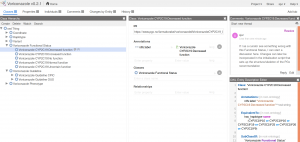Difference between revisions of "WebProtege"
Farmakorakel (talk | contribs) |
Farmakorakel (talk | contribs) (→Using WebProtégé for curation of PGx recommendations) |
||
| Line 19: | Line 19: | ||
[[File:WebProtege user interface func status.png|frameless|Inspection of the element ''Voriconazole CYP2C19: Decreased function'' from the Class Hierarchy describing PGx recommendations for the drug Voriconazole]] | [[File:WebProtege user interface func status.png|frameless|Inspection of the element ''Voriconazole CYP2C19: Decreased function'' from the Class Hierarchy describing PGx recommendations for the drug Voriconazole]] | ||
| + | |||
| + | Although the Functional Status can be manually modified by the curator, we believe that it is better to edit the Functional Status programmatically, based on the current PharmGKB functional status. By starting a discussion in the ''Comment'' view, suggestions can be included in the next version of the ontology: | ||
| + | |||
| + | [[File:WebProtege user interface func status discussion.png|frameless|Comments can be added]] | ||
Revision as of 13:22, 20 September 2018
A general tutorial for Protégé (desktop and web-version) can be found at the Protégé Wiki.
The best Protégé tool for looking at OWL semantics is the desktop version of Protégé, which is a visual front-end to the OWLAPI.
However, for collaborative curation of OWLs it may be better to use the WebProtege. We host our own copy of WebProtégé.
User interface of Pharmacoracle's WebProtégé
When opening an OUS adapted PharmGKB OWL file in WebProtégé for the first time, we are presented to the Classes tab with the four views Class Hierarchy (a tree of all class entities of this ontology), Class (for description and editing of each class entity), Comments (for chatting with other curators), Project Feed (to see changes to the project.):
The user interface of WebProtégé can be modified. We suggest to replace the view Project Feed with the view OWL Entity Description Editor. In this way the editor/curator can inspect semantic properties of the class entities that are not shown in the default view. We suggest to remove the Project Feed in order to make the interface cleaner. The user can modify the interface as she or he pleases. Available views can be browsed by clicking on the three-bar symbol next to the Classes tab:
Using WebProtégé for curation of PGx recommendations
We suppose that the user has modified the Classes tab as explained above. We will use the drug voriconazole as an example. By navigating in the Class Hierachy view, the curator can e.g. view the class element Voriconazole CYP2C19:Decreased function. The naming is based on the functional status that is provided by PharmGKB's API, and the drug and gene name is added because functional status is gene specific and possibly drug specific (may be sensible to make functional status independent of drug, cf. Voriconazole Phenotype below). In the definition of the Voriconazole CYP2C19:Decreased function, pay attention to the OWL Entity Description Editor where we see that the Voriconazole CYP2C19:Decreased function is equivalent to a gene that has haplotype either CYP2C19*10, CYP2C19*16, CYP2C19*19, CYP2C19*25, CYP2C19*26 or CYP2C19*9:
Although the Functional Status can be manually modified by the curator, we believe that it is better to edit the Functional Status programmatically, based on the current PharmGKB functional status. By starting a discussion in the Comment view, suggestions can be included in the next version of the ontology:



